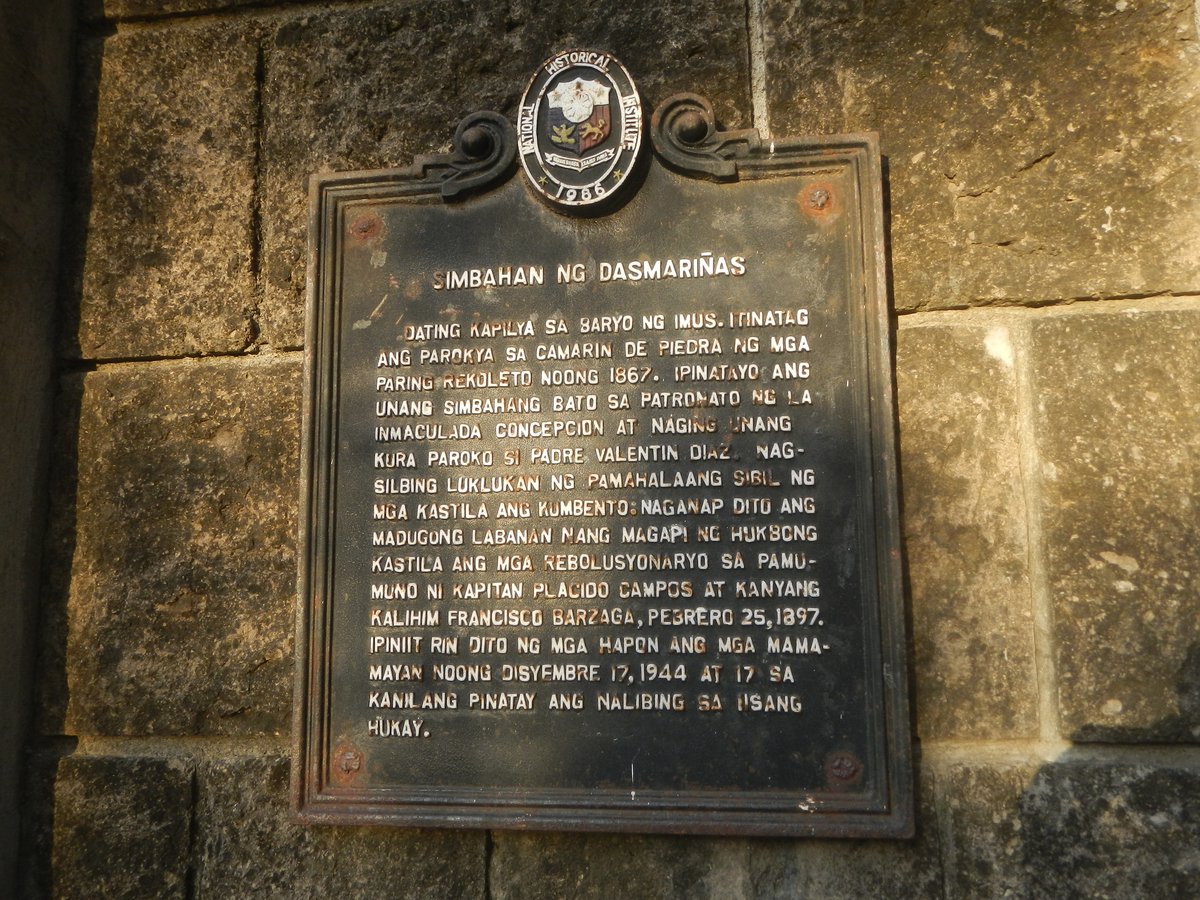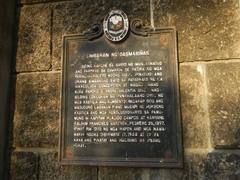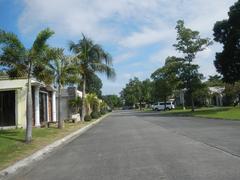
Church of Dasmariñas Historical Marker: Visiting Hours, Tickets, and Visitor Guide
Date: 14/06/2025
Introduction: The Living Legacy of the Church of Dasmariñas
In the heart of Dasmariñas, Cavite, the Church of Dasmariñas—commonly referred to as the Immaculate Conception Parish Church—stands as a monument to centuries of Filipino faith, resilience, and artistry. This Spanish colonial-era structure not only attracts worshippers but also welcomes tourists, scholars, and heritage enthusiasts eager to explore its storied past and vibrant present. Recognized by a historical marker from the National Historical Commission of the Philippines, the church is a living testament to the city’s cultural identity and its pivotal role during the Philippine Revolution (Traveltill.com; Wikipedia; touristplaces.guide).
This comprehensive guide offers detailed insights into the church’s history, architectural features, artistic treasures, and community significance. It also provides practical information on visiting hours, ticketing (donation-based entry), accessibility, and tips for a fulfilling visit. Whether you’re a history buff, a spiritual pilgrim, or a curious traveler, the Church of Dasmariñas promises an enriching encounter with Philippine heritage (Kurby Blog; Audiala).
Table of Contents
- Introduction
- Historical Background
- Architectural and Artistic Heritage
- Preservation and Restoration
- Community Role and Cultural Impact
- Visiting Information
- Nearby Attractions and Travel Tips
- Frequently Asked Questions (FAQ)
- Conclusion
- References
Historical Background
Founding and Early History
The Church of Dasmariñas traces its roots to the 19th century, when the area was formally separated from Imus and established as its own parish in 1864. This move, spearheaded by local and ecclesiastical leaders—including the Archbishop of Manila and the Augustinian Recollects—solidified Dasmariñas’s identity as an independent community (Traveltill.com). The resulting parish church became the heart of civic and spiritual life.
The Augustinian Recollects played a formative role in shaping the town’s religious and educational landscape, with the church evolving into a center for worship, community gatherings, and local governance.
The Church in the Philippine Revolution
The church’s significance extends beyond its religious function. In 1897, during the Philippine Revolution, it became a sanctuary for hundreds of Filipino families fleeing violence during the Spanish offensive led by General José de Lachambre. This tragic period, known as the Battle of Perez Dasmariñas, is commemorated by the church’s historical marker, underscoring its role as both a place of refuge and a witness to the struggle for independence (Bilkenn).
Architectural and Artistic Heritage
Spanish Colonial Features
The Church of Dasmariñas exemplifies Spanish colonial ecclesiastical architecture. Its thick stone walls, cruciform layout, and prominent bell tower not only embody European design principles but are also adapted to withstand local climatic challenges such as typhoons and earthquakes (diskurso.ph). The façade, adorned with arched windows and robust buttresses, reflects the harmonious fusion of European and Filipino craftsmanship.
Stained Glass and Altarpiece
Inside, the church dazzles with brilliant stained-glass windows that depict Marian iconography and biblical scenes, illuminating the sanctuary with vibrant color. The retablo (altar backdrop), carved from local hardwood and gilded with gold leaf, features statues of saints, with the central niche dedicated to the Immaculate Conception. The artistry pays homage to both Spanish Baroque traditions and indigenous creativity (diskurso.ph).
Symbolism and Iconography
Religious symbolism is woven throughout the church’s design. Marian symbols such as the lily (purity), crescent moon (Immaculate Conception), and crown (Queenship of Mary) are prominent in stained glass, altar carvings, and architectural details. Statues and reliefs serve as visual aids for devotion and catechesis.
Preservation and Restoration
The church has undergone several careful restorations to preserve its Spanish colonial character while ensuring structural integrity. Traditional masonry techniques have been used to repair stonework, and stained glass panels have been restored to their original brilliance. The historical marker, installed in 1986, formally recognizes the church’s enduring cultural significance (CitySearchPhilippines).
Community Role and Cultural Impact
The Church of Dasmariñas is more than an architectural marvel—it is the spiritual and social heart of the city. It hosts daily masses, sacraments, and major religious festivals such as the feast of the Immaculate Conception (December 8), Holy Week, and Christmas. These events draw large crowds and foster a sense of unity and cultural pride.
The church also plays a crucial role in community outreach, education, and charitable initiatives, working with local institutions and organizations to promote heritage preservation and social welfare (HopnCruise).
Visiting Information
Visiting Hours
- Open daily: 6:00 AM – 7:00 PM
- Hours may vary during special events or holidays; check the parish’s official channels for updates.
Admission and Tickets
- Entry is free for all visitors.
- Donations are encouraged to support the church’s maintenance and preservation efforts.
Accessibility
- The church is wheelchair accessible, with ramps at main entrances and designated seating.
- Restroom facilities are available, and staff can assist visitors with special needs.
Guided Tours and Special Events
- Guided tours can be arranged through the parish office, especially during heritage month and major festivals.
- The church is a focal point for local celebrations, including the Paruparo Festival and other community gatherings.
Visitor Etiquette
- Dress modestly: cover shoulders and knees.
- Remove hats inside the church.
- Maintain silence during religious services; photography is permitted except during mass or private ceremonies.
Nearby Attractions and Travel Tips
- Dasmariñas City Plaza: Adjacent to the church, ideal for relaxation and people-watching.
- Museo De La Salle & Kadiwa Park: For a broader cultural experience.
- Local markets and eateries: Sample Cavite’s delicacies and shop for souvenirs.
- Getting there: Easily accessible by jeepney, tricycle, or private vehicle. The church is centrally located, making it a convenient stop on a city tour (diskurso.ph).
Tips:
- Early mornings and weekdays offer a quieter atmosphere.
- Always check the parish office or official social media for event schedules and possible changes in visiting hours.
Frequently Asked Questions (FAQ)
Q: What are the Church of Dasmariñas visiting hours?
A: The church is open daily from 6:00 AM to 7:00 PM.
Q: Is there an entrance fee?
A: Admission is free; donations are welcome.
Q: Are guided tours available?
A: Yes, they can be arranged through the parish office, especially during festivals and heritage months.
Q: Is the church accessible to persons with disabilities?
A: Yes, ramps and accessible facilities are available.
Q: When is the best time to visit?
A: The dry season (November–April) is ideal. Weekdays and early mornings are quieter.
Conclusion
The Church of Dasmariñas stands as a vibrant symbol of Filipino heritage, spirituality, and community resilience. Its Spanish colonial architecture, breathtaking artistic details, and deep historical roots offer visitors a unique opportunity to engage with the city’s past and present. With generous visiting hours, free admission, and accessible facilities, the church invites everyone to explore, reflect, and be inspired by its enduring legacy.
For the latest updates, guided tour availability, and more travel tips, download the Audiala app and follow the church’s official channels. Experience one of Cavite’s most cherished historical sites and discover the stories that have shaped Dasmariñas into the city it is today (Audiala).
References
- Traveltill.com: History of Dasmariñas
- Travalour.com: Immaculate Conception Parish Church
- Diskurso.ph: City of Dasmariñas Guide
- Wikipedia: Immaculate Conception Parish Church (Dasmariñas)
- Kurby Blog: The Evolution of Dasmariñas Architecture
- Audiala: Dasmariñas Heritage and Visitor Information
- Touristplaces.guide: Top Tourist Places in Dasmariñas
- Bilkenn: Cavite Historical Places

